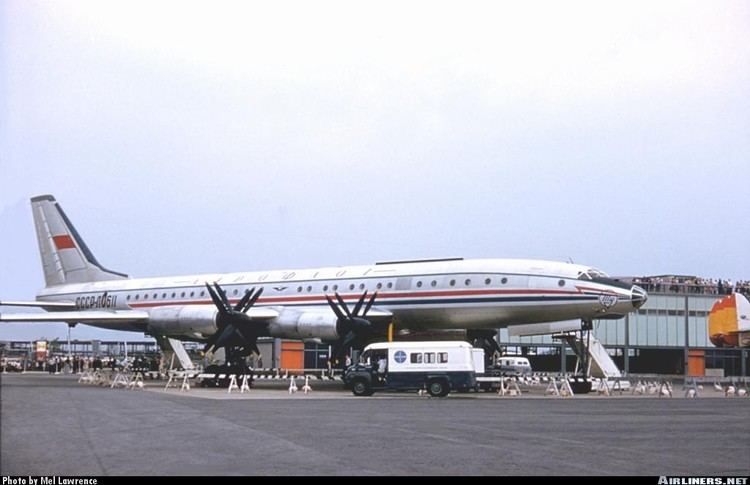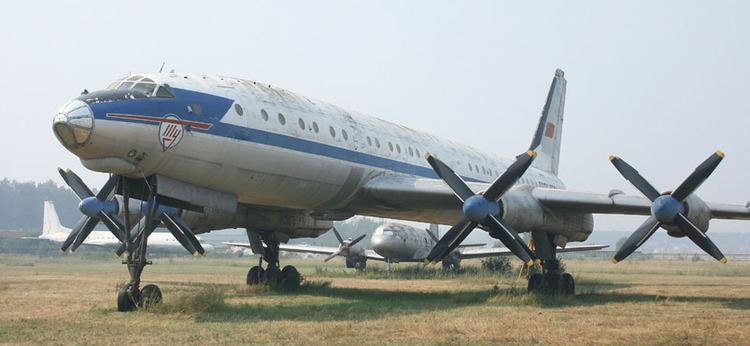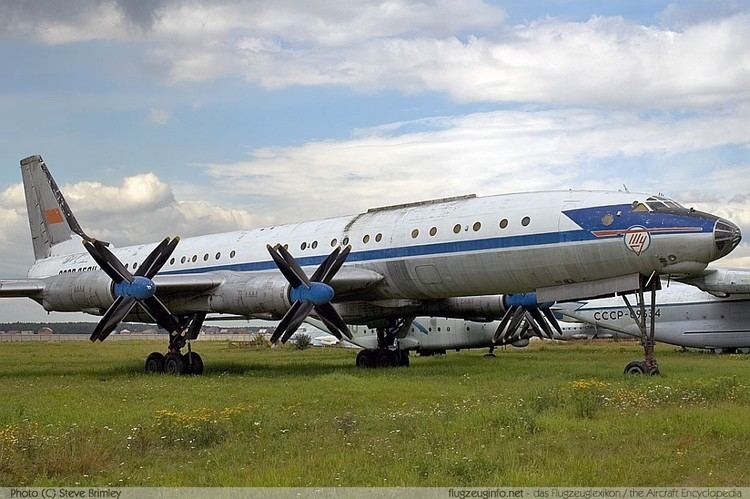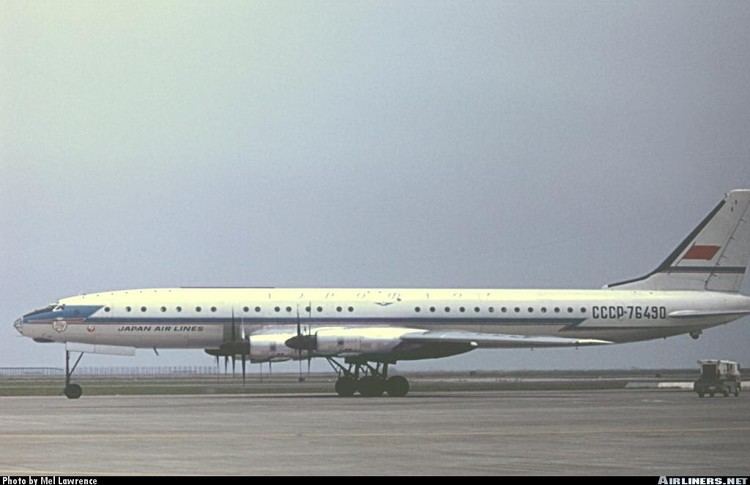Top speed 870 km/h Wingspan 51 m | Length 54 m Introduced 24 April 1961 First flight November 15, 1957 | |
 | ||
Tupolev tu 114 nato code cleat
The Tupolev Tu-114 Rossiya (Russian: Tyполев Тy-114 Poccия) (NATO reporting name Cleat) is a turboprop-powered long-range airliner designed by the Tupolev design bureau and built in the USSR from May 1955. The aircraft was the largest and fastest passenger plane at that time and also had the longest range (10,900 km (6,800 mi)). It has held the official title of fastest propeller-driven aircraft since 1960.
Contents
- Tupolev tu 114 nato code cleat
- Tupolev tu 114 rossiya nato code cleat
- Development
- Design
- Operational history
- JAL service
- World records
- Variants
- Tu 116
- Tu 126
- Civil
- Military
- Accidents and incidents
- Specifications Tu 114
- References

Due to its swept wing and powerplant design, the Tu-114 was able to travel at speeds typical of modern jetliners (880 km/h (550 mph)). Although it was able to accommodate 224 passengers, when operated by Aeroflot, it was more common to provide 170 sleeping berths and a dining lounge.

In 14 years of civilian service, the Tu-114 was reported to have a high level of safety and reliability. The Tu-114 carried over six million passengers before being replaced by the jet-powered Ilyushin Il-62. 32 aircraft were built at the Kuibyshev aviation plant (№18) in the early 1960s.

Tupolev tu 114 rossiya nato code cleat
Development

In response to a directive No.1561-868 from the Council of Ministers and Ministry of Aircraft Production order No.571, issued in August 1955, the Tupolev Design Bureau was to create an airliner that had a range of 8,000 km (4,971 mi), based on the Tupolev Tu-95 strategic bomber, powered by 4 powerful Kuznetsov NK-12 engines driving massive contra-rotating propellers.

The Tu-114 used the basic wing, empennage, landing gear, and powerplants of the Tu-95 bomber, mated to a totally new pressurized fuselage of much larger diameter. To cope with the increased weight, increased landing flap surface area was required, and the flap chord was increased compared to the bomber's flaps. The wing was mounted low on the fuselage, giving the Tu-114 a much higher stance on its landing gear than the bomber. As a result, a new nose landing gear strut was required, although the main landing gear remained unchanged.

The Tu-114 was able to reach speeds typical of modern jetliners (880 km/h), but its cruising speed equivalent to Mach 0.71 was markedly lower than equivalent jet airliners such as the Boeing 707, Douglas DC-8, and Vickers VC10, which usually cruised at Mach 0.83. It carried up to 224 passengers in maximum carriage configuration, although a more usual number for long-distance transcontinental flights was 170 passengers, which enabled the planes to be fitted with such luxuries as sleeping berths and even a dining lounge for the upper-class cabin.
Design
The Tu-114 had several unique technological features for its time such as:
Early Tu-114s were also unique within Aeroflot for their three class layout, differing in comfort: economy, first and deluxe. In the front economy cabin were set 41 (3×3) seats, the middle first-class cabin had 48 seats with tables and table lamps, followed by four compartments for 24 day or 12 beds and the third cabin located 54 passenger seats in a 3×3 arrangement. Later, these compartments were dismantled and replaced with the usual passenger seats. The design was not without shortcomings. Passengers on the Tu-114 endured high noise levels (108–112 dB) and vibrations from the engines.
Operational history
The first Tu-114, registration CCCP-Л5611, was first shown to the West in 1958 at the Brussels World Exhibition. It later carried Nikita Khrushchev on his first trip to the US, the first such visit by any Soviet leader. When it arrived at Andrews Air Force Base, the ground crew found that the aircraft was so large and its landing gear so tall that they had no passenger steps high enough to reach the forward hatch. Khrushchev and his party were obliged to use the aircraft's own emergency escape ladder. The last flight of this particular plane was in 1968, and it is now on display at the Central Air Force Museum at Monino, outside of Moscow. Similar issues were experienced when the plane first landed at London and Paris airports, neither of which had hosted a plane of this size.
The Tu-114 entered regular Aeroflot service on flights from Vnukovo Airport in Moscow to Khabarovsk on 24 April 1961. It was subsequently used for Aeroflot flights to international destinations including Copenhagen, Havana, Montreal, New Delhi, Paris, Belgrade and Tokyo (in co-operation with JAL).
Flights to Havana via Conakry in Guinea began 10 July 1962. After the US government placed political pressure on Guinea, landing rights were denied after four flights, and the Tu-114 service had to be routed through Dakar, Senegal instead. Further American pressure to isolate Cuba resulted in denial of landing rights after three flights, and the route was changed to Algiers, Algeria instead. After three more flights, Algiers was also closed to the Tu-114. To overcome this, the Tu-114 was specially modified into the long-range Tu-114D variant, with seating reduced from 170 to 60, and 15 extra fuel tanks added. These aircraft operated from Murmansk, in the far north of the Soviet Union, and then entirely over the ocean to Havana. Usually this fuel load was enough, but in case of strong headwinds, an emergency refueling stop in Nassau in the Bahamas was necessary (ironically, this was an American military field). All planes operating this route were converted back to normal specifications after the jet-powered Ilyushin Il-62 began flying the Moscow – Havana route.
Aeroflot first appeared in the OAG in the January 1967 issue, which shows
The May 1967 OAG adds the weekly flight to Tokyo taking 10-35 and the return to SVO in 11-25.
Ilyushin 62s took over the Delhi and Montreal flights in 1967 (though the August 1968 OAG shows a weekly SVO-YUL-HAV Tu-114 along with a weekly Tu-114 via Algiers). Ilyushins took over the Tokyo flight in May/June 1969 and Havana probably sometime in 1969.
With the increasing use of the Il-62, the Tu-114s were shifted to long domestic flights from Domodedovo to Alma-Ata, Tashkent, Novosibirsk and Khabarovsk. Tu-114s were also used for charter operations for senior officials of the USSR and various official delegations.
The Tu-114 had a short commercial service life compared to other Soviet airliners, being operated on regular flights from 1962 to 1976 (in comparison, the Il-62 is still in civilian service 47 years after its introduction, as of 2014). The fatigue life of the airframe was set at 14,000 flying hours. Most of the aircraft passed this point in 1976. By the summer of 1977, Aeroflot decided to scrap 21 aircraft at the same time. A few continued in use by the Soviet Air Force until 1991.
The Tu-114 was known for reliability, speed and fuel economy. Tu-114 was reported to burn 5,600 kg/hour at first hour and 4,000-4,400 kg/hour after. Its safety record was rarely matched (there was only one accident involving fatalities but the plane was not airborne at the time) and was only withdrawn from service after the introduction of the Il-62 and after carrying over six million passengers with Aeroflot and Japan Airlines.
JAL service
For the Moscow – Tokyo route, Japan Air Lines made an agreement with Aeroflot to use the Tu-114. The flight crew included one JAL member, and the cabin crew consisted of five each from Aeroflot and JAL. The seating was changed to a two-class layout with 105 seats, and the aircraft livery included a small JAL logo and lettering on the forward fuselage. The first flight was on April 17, 1967. In 1969 the Moscow – Tokyo Tu-114 flights ended and the four involved planes converted back to the 200 seat domestic layout.
World records
In June 1959 the Aviation Sports committee of the Central Air Club named after Valeriy P. Chkalov approached the Tupolev OKB suggesting that various aviation records could be taken by Tupolev-designed aircraft. The Tupolev OKB prepared a detailed plan for record attempts on the Tu-16, Tu-104, Tu-104B, Tu-95M and Tu-114. The second pre-production Tu-114 (CCCP-76459) was prepared and clearance obtained to fly with the 30-tonne (metric ton) payload required for some of the record attempts. In a series of flight beginning on 24 March 1960 the Tu-114 achieved the following records in Sub-class C-1 (landplanes) Group 2 (turboprop):
All these records stand but the category was discontinued when the category was split into take-off weight sub groups. Similar records have been set in the new sub-groups by Tu-95 and Tu-142 aircraft at faster speeds.
Variants
Tu-116
The Tu-116 was a Tu-95 bomber fitted with pressurized passenger cabins built to serve as the official government transport. The two passenger cabins were fitted in the space of bomb bays and were not connected to each other or the flight deck.
Tu-126
The Tu-126 (NATO reporting name Moss) was used by the Soviet Air Force in the AEW role until being replaced by the Beriev A-50.
Civil
Military
Accidents and incidents
During its service life the Tu-114 had only one fatal accident. On 17 February 1966, a Tu-114 pilot attempted to take off from Sheremetyevo Airport in Moscow at night in deteriorating weather conditions after the flight had been delayed several times. The crew were unaware that snow had not been properly cleared from the full width of the runway involved. The plane's wing struck a large snow mound at speed and the propellers of No.3 and 4 engines impacted with the runway, resulting in the aircraft veering off course and burning. Initial Soviet sources suggested that 48 of 70 persons on board were killed, including the pilot. The aircraft was operating as Aeroflot Flight 65 and was bound for Brazzaville, Republic of the Congo with a number of Africans and a Soviet trade delegation on board. Later reports give the fatalities as 21 of 48 on board.
Another non-operational example was written off with fuselage damage in August 1962 at Vnukovo Airport after the undercarriage nose gear collapsed during servicing. Tail number CCCP-76479 was one of only three long range D models manufactured.
Specifications (Tu-114)
General characteristics
Performance
